 |
 |
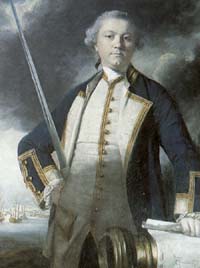 Augustus John, 3rd Earl of Bristol by Sir Joshua Reynolds, 1762
|
Fine and Decorative Art
The Museum houses important collections of family portraits; scenes of local topgraphical significance and works by a number of artists who came from the area around Bury, including three distinguished women artists. Decorative art collections include ceramics, furnishings and objects d'art, but unfortunately not all of the collections can be on display at Moyse's Hall at any one time.
THE CULLUM COLLECTION
The Cullum family owned the Hardwick and Hawstead estates on the outskirts of Bury St Edmunds. They were purchased in 1656 by Sir Thomas Cullum, 1st Baronet, a wealthy London draper who was knighted by Charles II in recognition of his services to the Royalist cause. When George Gery Milner-Gibson Cullum, the last surviving member of the family, died in 1921 he decided to leave the family fine and decorative art collections to the Borough.
The family portraits span three centuries from the seventeenth to the twentieth century and include works by several leading British artists. Among notable eighteenth-century portraits are those of the 6th Baronet, the Reverend Sir John Cullum, who was a keen botanist and genealogist and published the History of Hawstead in 1785.
The most distinguished nineteenth-century family portrait depicts Sydney Milner-Gibson, granddaughter of the Reverend Sir John Gery Cullum, who was the 8th and last Baronet. It was commissioned in 1871 by Sydney's half-brother Thomas Bowles from his friend the French artist James Tissot (1835-1902). Tissot had recently been obliged to flee from Paris following the ravages caused by the Franco-Prussian War and, settled in his friend Bowles' house in London, was eager for portrait work. On completion in the Spring of 1872, the portrait was presented to Sydney probably as a late twenty-first birthday present.
|
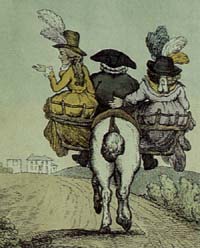 Me, My Wife and Daughter by Henry Bunbury |
HENRY BUNBURY (1750-1811) Henry William Bunbury was the younger son of the Reverend Sir William Bunbury, 5th Baronet, who had estates at Mildenhall and Great Barton. He was educated locally, at Westminster School and St Catharine's College, Cambridge. It was there that he began to sketch satirical scenes of college life to amuse his fellow students. Unlike his slightly younger contemporaries Rowlandson and Gilray, Bunbury preferred social to political satire and in this vein he poked fun at many of the fashions and foibles of the age. Some of his most amusing prints depict horsemen, university life and episodes from his time as captain of the West Suffolk Militia, as well as local scenes and caricatures of local tradespeople. Although Bunbury moved chiefly in fashionable London circles - he was Groom of the Bedchamber to the son of George III - he frequently returned to Bury St Edmunds. Highly popular and a 'bit of a lad', he is described in later life by the diarist Joseph Farington as 'living most of his time a sotting life at Bury in Suffolk'.
|
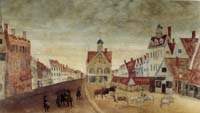 Market Hill with beasts, c. 1700 |
LOCAL SCENES The first woman to serve as a councillor and Mayor was Mrs Eva Wollaston Greene. In 1933 she presented her husband John's large collection of topographical prints to the Borough. The prints date mainly from the eighteenth century and include some fine views of Angel Hill and the abbey precincts by Jacob Kendall (1741-89). He was a friend of the artist Henry Bunbury, and it is thought that Bunbury added the elegant and lively figures to some of Kendall's compositions. Other notable artists represented in this collection include Henry Davy (?1780-1833) and William Pickett (fl 1792-1820). |
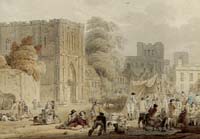 Autumn Fair on Angel Hill, watercolour by Joseph Clarendon Smith, 1808 |
In addition to the Greene Collection, there are other prints and paintings representing important chapters in the history of Bury St Edmunds. Joseph Clarendon Smith records the Autumn Fair on Angel Hill (1808), which was a popular annual event, discontinued later in the nineteenth century because of the drunken and rowdy behaviour it attracted, while a naive oil on panel painting depicts the market in 1700.
|
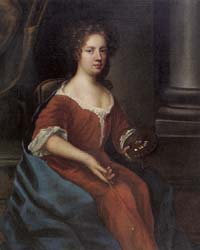 Self portrait by Mary Beale, c. 1675 |
THREE WOMEN ARTISTS: Mary Beale (1633-99) One of the most important local artists represented in the collection is Mary Beale. Born daughter of John Cradock, Rector of Barrow near Bury St Edmunds, she married a distant cousin, Charles Beale, and moved to London. She had already received training as an artist and, with additional advice from Sir Peter Lely and other notable practitioners of the period, she set up her own studio. It was unusual for a woman to become a professional artist at this time but Mary Beale soon built up a considerable clientele, especially among the new breed of leading Puritans. Indeed, she became so successful that her husband chose to abandon his own career in order to act as her assistant and secretary. Following a bequest in 1993, the museum now holds the largest and best public collection of Mary Beale's work, notable examples of which include a portrait of her husband, painted around 1680, and one of her early self-portraits, c.1675, in which she is shown with her paintbrushes and palette. Although she was highly rated by her contemporaries, her work was later unfavourably compared with her more illustrious male counterparts. Only recently has it been reassessed and given the recognition it deserves. |
 Barbara Stone by Rose Mead,c. 1930 |
Rose Mead (1867-1946) Rose Mead, the daughter of a local builder, studied at Lincoln Art College, the Westminster School and in a private studio in Paris. She exhibited some early works in the Royal Academy, but by 1900 had returned to Bury St Edmunds, where she spent the rest of her life. Having established a studio in Crown Street, she made a living from painting portraits, local views, interiors and still lifes. The museum has a good representative collection of her work. One of the most popular portraits is that of her elderly housekeeper Barbara Stone, shown peeling apples at the kitchen table. |
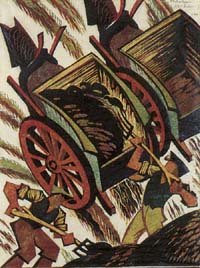 Michaelmas, a linocut in three colours on Japanese mulberry tissue by Sybil Andrews, c. 1935 |
Sybil Andrews (1898-1992) Sybil Andrews had a distinctive approach, although her early watercolours record the same buildings that Rose Mead also loved to paint. In 1925 she moved to London, where she studied at the newly established Grosvenor School of Modern Art. Under her tutor, the avant-garde artist Claude Flight, she began to experiment with printing techniques. The result was a series of highly individual colour linocuts, which today have given her an international reputation. Hand-printed on Japanese tissue paper, many of the linocuts reflect the machine age and urban life, but others are of rural life inspired by the artist's early years in Suffolk, and she continued to produce these even after emigrating to Canada in 1947.
|
| Go to Museums Homepage | Updated 17 August 2009 | Go to Home Page |